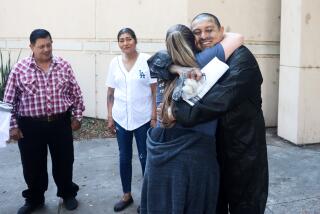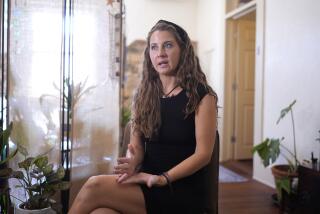Mistakes Conceded in Newborn Mix-Up
The mix-up of two newborns at St. Joseph Hospital in Orange was the result of a series of errors thought to have begun when the infant boys were placed in the wrong bassinets, and their true identities then repeatedly overlooked, officials conceded Monday.
It is the kind of mistake that is never supposed to happen, the kind of mistake that is every new parent’s nightmare. This one has already caused St. Joseph to launch an internal investigation and change its policies for monitoring newborns and may trigger renewed efforts at hospitals nationwide.
At St. Joseph, newborns are fitted with bracelets that carry their names and unique identification numbers, a system that is routine at many hospitals. Parents are given matching bracelets and the hospital staff is charged with double-checking the numbers to make sure they are the same whenever an infant is handed over to a nursing mother or placed back in a bassinet that also carries an identification tag.
But all the precautions failed Sunday when one baby was sent home with the wrong parents. The mix-up was discovered only after the other mother who remained in the hospital realized she had breast-fed the wrong baby.
Hospital president Larry Ainsworth apologized Monday for the “regrettable” situation that he blamed on human error and conceded that the mix-up involved two baby boys who are “entirely different in their last names, and that should have been able to have been recognized.”
To confirm the two babies are now correctly placed with their parents, the hospital conducted antibody tests that match mother and child. Because both mothers had breast-fed the wrong children, hospital officials also tested the babies and their parents for hepatitis B and HIV, which can be passed via mothers’ milk. Those test results will be passed on to parents within the week, officials said.
Iliana Bravo and Brian Lambert of Tustin, who went home Sunday with the newborn they mistakenly believed to be their son, Aaron Alexander Lambert, said they are just relieved they have the right baby.
“I just thank God it’s over. We’re going to try to forget this and move on,” Bravo said. “It’s 100% our baby. . . . He looks like his father.”
The other parents, who have asked not to be identified, also have left the hospital after being reunited with their child, who was born Thursday.
Four nurses who had direct contact with the infants have been placed on temporary leave. Some were questioned Monday, and more interviews will resume today as part of the hospital’s internal investigation, Ainsworth said.
Effective immediately, the hospital also has stepped up patient check-out precautions to prevent a similar mistake, Ainsworth said, adding that the hospital will now require two nurses and the mother to double-check information before discharging newborns.
“All of us who are parents know this is a very frightening circumstance,” Ainsworth said. “[We] feel very badly about this.”
Newborns are removed from their bassinets several times a day to be fed, weighed and bathed, Ainsworth said. And, perhaps, the babies were inadvertently switched during those rounds, he said.
“Clearly, the procedure is when you put back the baby in the bassinet, you’re supposed to put the newborn in the bassinet with the right name card,” Ainsworth said. “There is a possibility that that did not happen and that the babies were, at some point, not placed in the correct bassinet.”
ID Wristbands Were Overlooked
Ainsworth said the hospital staff later erred again when Bravo and Lambert left with the wrong child. Hospital policy requires that the mother’s and child’s identification wristbands be clipped and attached to their release form.
A nurse is charged with verifying that the tags match and requiring the parents to also sign the form to further double-check that a child is being discharged with his or her biological parents. In this case, however, the mismatched wrist bracelets were overlooked.
“[The Lamberts’] form was all nicely filled out, but the problem was that the baby’s name [on the bracelet] was clearly different from the mother’s name,” Ainsworth said. “It seems to me that neither the nurse nor the mother took a close look at the ID bracelets.”
Meanwhile, Aaron was mistakenly given to and fed by another new mother who remained at St. Joseph Hospital. This mother noticed that Aaron’s wristband looked unfamiliar and alerted hospital authorities, who soon realized what happened.
After going home from the hospital, Bravo had breast-fed the baby she believed was hers and was resting when hospital officials called to deliver the shocking news.
“I was [like] ‘What? What are you talking about?’ ” Bravo said, adding that hospital officials told her, “You need to come right away.”
Brian Lambert on Monday blasted hospital officials for the mistake. He said he didn’t pay close attention to the names on the form because “they just said sign here and so I did. . . . They are the ones who screwed up.”
Lambert added that he and his wife are considering legal action against the hospital.
The discovery that two infants were mistakenly given to the wrong mothers was reported by media across the nation Monday, and the hospital was barraged with phone calls and visits from reporters and television crews.
Administrators at several hospitals said the high-profile incident may cause medical facilities nationwide to review their procedures for discharging newborns to prevent a similar mix-up.
The risk of a new mother going home with the wrong child is extremely small.
Hospitals install what are believed to be fail-safe--and in some cases, high-tech--systems in which the identity of newborns is constantly monitored by doctors, nurses, hospital staff and parents alike.
But infants can be hard to tell apart in the first few days of birth when every day brings change in their appearance and hospital routine and feeding schedules take them in and out of their parents’ grasp. That’s why hospitals are so diligent.
About 4 million babies are born in the United States each year, but “switches” have occurred in only a handful of cases, according to a recent national study.
A well-publicized incident at the University of Virginia Medical Center last year brought home the fact, however remote, that switches do occur. The families of two girls born in the summer of 1995 discovered last July that the mothers had been sent home with each other’s newborns.
And in August 1998, a woman who had given birth to a son at Lowell General Hospital in Massachusetts breast-fed the baby handed to her by a nurse, then discovered the infant was a girl.
Hospital security systems vary nationwide. Many have systems in place similar to St. Joseph’s, but others have opted for more sophisticated electronic systems.
At Saddleback Memorial Medical Center in Laguna Hills, newborns rarely leave their mother’s side unless the child is sick or the mother pleads for a little peace and quiet.
Infants also wear a wristband that contains an embedded microchip designed to trigger an alarm if the child is taken past special security gates without authorization--much like the anti-theft system in place at the local mall.
“We think this offers the most protection available to new families,” Saddleback spokeswoman Jill Kennedy said.
Times staff writer Tini Tran also contributed to this report.
More to Read
Sign up for Essential California
The most important California stories and recommendations in your inbox every morning.
You may occasionally receive promotional content from the Los Angeles Times.










